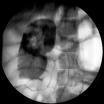
Gadolinium-based
contrast material
Gadolinium-based contrast material used in magnetic resonance imaging (MRI) increases the risk for nephrogenic systemic fibrosis (NSF), according to a report in the June issue of the American Journal of Kidney Diseases.
Dr. Alexander J. Kallen from the Centers for Disease Control and Prevention, Atlanta, and colleagues conducted a case-control study of 19 patients with NSF treated at a St. Louis hospital dialysis unit and 57 matched controls from the same unit.
Fourteen patients with NSF had undergone MRI with contrast in the previous year, the authors report, with a median interval of 123 days from most recent contrast MRI to date of disease detection. Four of the remaining 5 patients had gadolinium exposure between 16 and 68 months before diagnosis.




Ad Statistics
Times Displayed: 44157
Times Visited: 1361 Keep biomedical devices ready to go, so care teams can be ready to care for patients. GE HealthCare’s ReadySee™ helps overcome frustrations due to lack of network and device visibility, manual troubleshooting, and downtime.
The risk for NSF increased in a stepwise fashion for having 1 MRI, 2 to 3 MRIs, or 4 or more MRIs, compared with controls, the report indicates.
On multivariate analysis, exposure to gadolinium- containing contrast in the preceding six months increased the risk for NSF 6.59-fold, and exposure in the preceding one year increased the risk for NSF 8.97-fold.
The authors concluded that providers should carefully weigh both the benefits and potential harms of contrast MRI in their clinical decision making and avoid the use of gadolinium contrast agents if possible in patients with renal failure. They said that if gadolinium contrast is needed, clinicians should use the lowest dose and limit the number of future contrast administrations, and they added that the mechanism by which gadolinium contrast might cause NSF is unknown.
In 2006, FDA first notified healthcare professionals and the public about the risk of NSF following exposure to gadolinium.
Am J Kidney Dis 2008;51:966-975.

